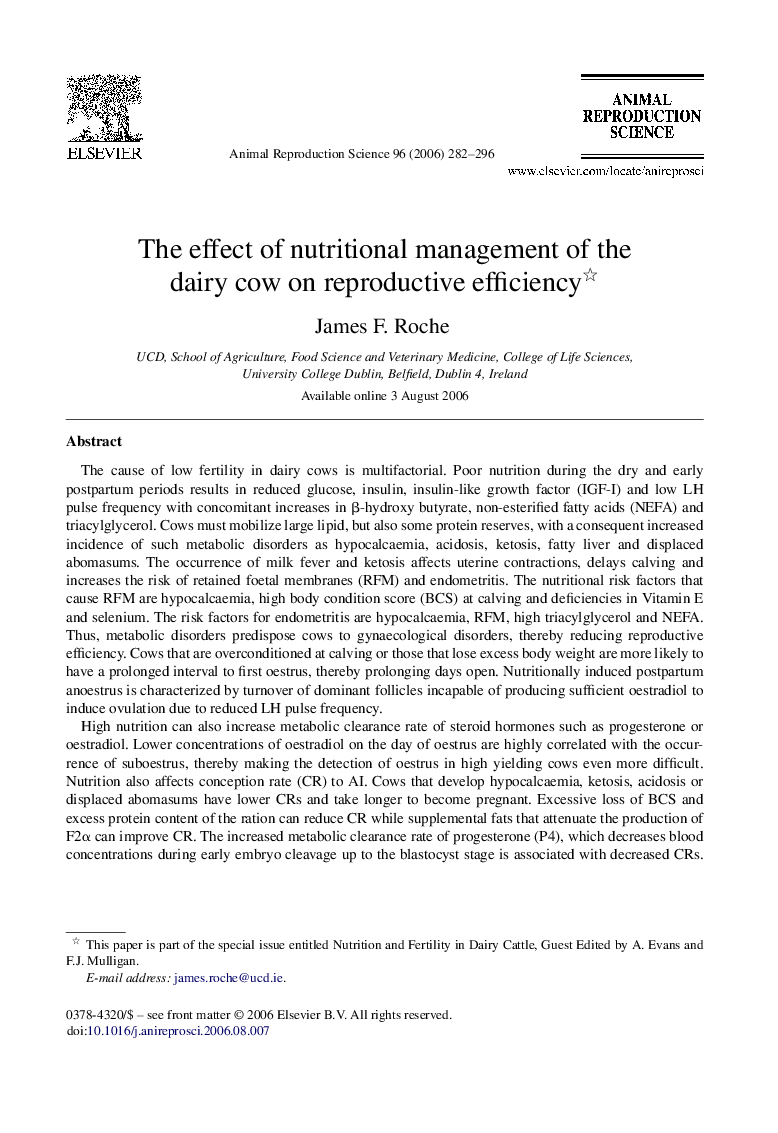| کد مقاله | کد نشریه | سال انتشار | مقاله انگلیسی | نسخه تمام متن |
|---|---|---|---|---|
| 2075016 | 1544823 | 2006 | 15 صفحه PDF | دانلود رایگان |

The cause of low fertility in dairy cows is multifactorial. Poor nutrition during the dry and early postpartum periods results in reduced glucose, insulin, insulin-like growth factor (IGF-I) and low LH pulse frequency with concomitant increases in β-hydroxy butyrate, non-esterified fatty acids (NEFA) and triacylglycerol. Cows must mobilize large lipid, but also some protein reserves, with a consequent increased incidence of such metabolic disorders as hypocalcaemia, acidosis, ketosis, fatty liver and displaced abomasums. The occurrence of milk fever and ketosis affects uterine contractions, delays calving and increases the risk of retained foetal membranes (RFM) and endometritis. The nutritional risk factors that cause RFM are hypocalcaemia, high body condition score (BCS) at calving and deficiencies in Vitamin E and selenium. The risk factors for endometritis are hypocalcaemia, RFM, high triacylglycerol and NEFA. Thus, metabolic disorders predispose cows to gynaecological disorders, thereby reducing reproductive efficiency. Cows that are overconditioned at calving or those that lose excess body weight are more likely to have a prolonged interval to first oestrus, thereby prolonging days open. Nutritionally induced postpartum anoestrus is characterized by turnover of dominant follicles incapable of producing sufficient oestradiol to induce ovulation due to reduced LH pulse frequency.High nutrition can also increase metabolic clearance rate of steroid hormones such as progesterone or oestradiol. Lower concentrations of oestradiol on the day of oestrus are highly correlated with the occurrence of suboestrus, thereby making the detection of oestrus in high yielding cows even more difficult. Nutrition also affects conception rate (CR) to AI. Cows that develop hypocalcaemia, ketosis, acidosis or displaced abomasums have lower CRs and take longer to become pregnant. Excessive loss of BCS and excess protein content of the ration can reduce CR while supplemental fats that attenuate the production of F2α can improve CR. The increased metabolic clearance rate of progesterone (P4), which decreases blood concentrations during early embryo cleavage up to the blastocyst stage is associated with decreased CRs. In conclusion, poor nutritional management of the dairy cow, particularly before and after calving, is a key driver of infertility.
Journal: Animal Reproduction Science - Volume 96, Issues 3–4, December 2006, Pages 282–296